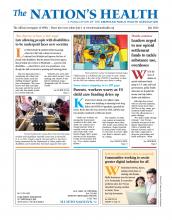
Photo by FG Trade Latin, courtesy iStockphoto
Whether paying bills, making travel plans or chatting with friends, Phyllis Krantzman uses the internet a lot. Fortunately, if connection problems arise, the 79-year-old public housing resident in Austin, Texas, has help downstairs.
“They’re good with technical support,” Krantzman told The Nation’s Health. “I know I’ve gone down there frustrated with my iPad or cellphone and Kim has helped me.”
“Kim” is community health worker Kimberlyn Barton-Reyes. Along with her colleagues, she helps public housing residents with technology issues, among other tasks. High on the list is maintaining internet access and support for low-income residents.
Digital access is recognized as an equity issue, as race, ethnicity, socioeconomic status, ZIP code and other social determinants play a role. That connection is one reason why Healthy People 2030, the federal initiative that establishes the nation’s health goals over a decade, made improving broadband access a health objective. People without reliable broadband access face professional, educational and health-related disadvantages. They can also miss out on telehealth visits, including mental health care services.
Unlocking the Connection, a program of the Housing Authority of the City of Austin, helps Krantzman and other residents maintain broadband access at the public housing site. The program began a decade ago when a high-speed broadband internet service expanded in the area.

Quincy Taylor uses the internet to do his homework at a Long Beach, California, library in 2017. His grandmother, Vickie Jones, at right, lacked access at home.
Photo by Scott Varley, courtesy Torrance Daily Breeze/Getty Images
Today 90% of residents in the city’s project-based rental program have access. The housing authority works with local and national organizations to provide devices, tech support and training to residents. Participants included seniors who learned how to get medications, groceries and medical supplies delivered during the ongoing COVID-19 pandemic.
“There’s a long way between a demonstration of how to do that and a resident having the skills and believing they are safe doing that,” Catherine Crago, head of strategic initiatives for the housing authority and its nonprofit subsidiary Austin Pathways, told The Nation’s Health.
While all but 5% of Americans used the internet in 2023, according to the Pew Research Center, the pandemic showed that not all access is equal. Stay-at-home measures drew new attention to inequities in internet access, as some people who followed the safety recommendations were cut off from reliable high-speed access.
An April 2021 Pew survey found that 60% of low-income people had connection problems, compared with 47% of people with middle incomes and 39% with high incomes. As of 2020, 22.3% of Americans in rural areas and 27.7% of Americans in tribal lands did not have access to the most basic broadband internet speeds, according to a Federal Communications Commission report.
The disparities have direct implications on education, workforce development and health, which are opportunity areas for digital equity, according to Bruce Clark, executive director of the Center for Digital Equity in Mecklenburg County, North Carolina.

A 2021 survey found 60% of low-income broadband users had connection problems, and 46% worried about paying for access.: Photo by Mario Arango, courtesy iStockphoto
To help residents in Mecklenburg County, the center uses a program that allows residents to work with a navigator to find affordable internet and laptops and learn new skills.
In a 12-month period that ended last June, navigators fielded over 3,000 requests for services, many from Charlotte-Mecklenburg Schools students whose report cards came with information about the program. The result was over 400 families signing up for the Affordable Connectivity Program, a $14 billion FCC program that gives low-income people discounts on broadband internet services.
“We’re constantly evolving with some degree of regularity, both engaging directly with residents for what they want, and using the information that they’re telling us to make decisions together,” Clark said.
After COVID-19 put a spotlight on digital equity, President Joe Biden signed the Infrastructure Investment and Jobs Act into law in November 2021. It included $42 billion for the Broadband Equity, Access and Deployment Program, which helps partners across the nation expand broadband access in underserved areas. The program also creates programs around workforce development and internet adoption.
The Digital Equity Act, which provided $2.75 billion for grant programs that promote digital inclusion and equity, was also in the infrastructure law. The act required states to develop digital equity plans based on feedback from communities about their technology needs.
“These are investments that are actually going to help ensure that we can upskill workforces, make sure that we put devices in people’s hands and have widespread digital proficiency,” Francella Ochillo, director of public engagement for the National Telecommunications and Information Administration, told The Nation’s Health.
Also in the infrastructure law was funding for the Affordable Connectivity Program, which was a long-term solution to FCC’s Emergency Broadband Benefit to help families afford internet during the COVID-19 pandemic.
However, as of May, Congress had not renewed funding for the Affordable Connectivity Program, jeopardizing access for 23 million households that signed up for the program over a one-year period, said Amy Huffman, policy director for the National Digital Inclusion Alliance.
“There’s not something to step in and take its place,” Huffman told The Nation’s Health. “The other consequence is that these other federal programs that were funded through the Infrastructure Investment and Jobs Act will also be negatively impacted by this program not being in existence because they were built upon this program being present.”
Crago said the housing authority helped sign up 450 households for the Affordable Connectivity Program. For Krantzman, the $30 a month she paid under the program could more than double after the program lapses. She said she will make sacrifices if needed to keep her connection, even if it means using her savings.
“The only way I can think about cutting back now is food,” Krantzman said. “The one thing I do is go on a cruise once a year. I guess I can not go on my cruise once a year, but that’s really important to me. I don’t drive. I don’t smoke. I don’t have pets. There’s not many ways I can cut back.”
In California, where 2.9 million people signed up for the Affordable Connectivity Program, some internet service providers do not want to continue offering affordable internet without the federal subsidy, according to Sunne Wright McPeak, president and CEO of the California Emerging Technology Fund.
Fortunately, California’s newly adopted Digital Equity Bill of Rights, signed into law in 2023, commits the state to supporting equitable, accessible, affordable and reliable broadband access for all state residents, which may offer some protection.
Such action is needed at the federal level, McPeak said. She recommended that U.S. policymakers adopt a measure that guarantees affordable internet access to everyone who participates in federal assistance programs, for starters.
“Let’s just make it easy,” she said.
For more information, visit https://thecenterfordigitalequity.org and www.fcc.gov/acp.
- Copyright The Nation’s Health, American Public Health Association









